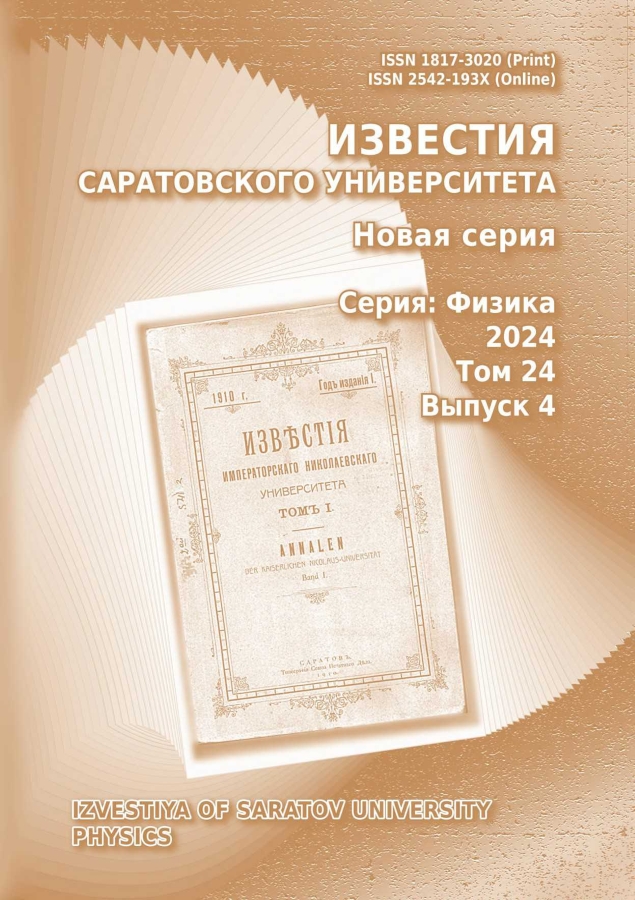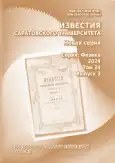Влияние штаммовых различий на устойчивость Staphylococcus aureus к фотодинамическому воздействию с использованием мезо-замещенных катионных порфиринов
- Авторы: Тучина Е.С.1, Корченова М.В.1, Закоян А.А.2,1, Тучин В.В.1
-
Учреждения:
- Саратовский национальный исследовательский государственный университет имени Н. Г. Чернышевского
- Научно-производственный центр «Армбиотехнология» НАН РА
- Выпуск: Том 24, № 3 (2024)
- Страницы: 216-227
- Раздел: Биофизика и медицинская физика
- URL: https://journals.rcsi.science/1817-3020/article/view/265413
- DOI: https://doi.org/10.18500/1817-3020-2024-24-3-216-227
- EDN: https://elibrary.ru/IELOFE
- ID: 265413
Цитировать
Полный текст
Аннотация
Об авторах
Елена Святославна Тучина
Саратовский национальный исследовательский государственный университет имени Н. Г. Чернышевского
ORCID iD: 0000-0003-4498-2846
410012, Россия, г. Саратов, ул. Астраханская, 83
Мария Владимировна Корченова
Саратовский национальный исследовательский государственный университет имени Н. Г. Чернышевского
ORCID iD: 0000-0002-5398-4045
410012, Россия, г. Саратов, ул. Астраханская, 83
Анна Артуровна Закоян
Научно-производственный центр «Армбиотехнология» НАН РА; Саратовский национальный исследовательский государственный университет имени Н. Г. Чернышевского
ORCID iD: 0000-0002-2360-3539
Scopus Author ID: 56770108300
Армения, 0056, г. Ереван, ул. Гюрджяна, д. 14
Валерий Викторович Тучин
Саратовский национальный исследовательский государственный университет имени Н. Г. Чернышевского
ORCID iD: 0000-0003-1194-9548
410012, Россия, г. Саратов, ул. Астраханская, 83
Список литературы
- Baptista M. D., Cadet J., Di Mascio P., Ghogare A. A., Greer A., Hamblin M. R., Lorente C., Núñez S. C., Ribeiro M. S., Thomas A. H., Vignoni M., Yoshimura T. M. Type I and Type II Photosensitized Oxidation Reactions: Guidelines and Mechanistic Pathways. Photochemistry and Photobiology, 2017, vol. 93, no. 4, pp. 912–919. https://doi.org/10.1111/php.12716
- Youf R., Müller M., Balasini A., Thétiot F., Müller M., Hascoët A., Jonas U., Schönherr H., Lemercier G., Montier T. Antimicrobial Photodynamic Therapy: Latest Developments with a Focus on Combinatory Strategies. Pharmaceutics, 2021, vol. 13, no. 12, article no. 1995. https://doi.org/10.3390/pharmaceutics13121995
- Feng Y., Tonon C. C., Ashraf S., Hasan T. Photodynamic and Antibiotic Therapy in Combination against Bacterial Infections: Efficacy, Determinants, Mechanisms, and Future Perspectives. Adv. Drug Deliv. Rev., 2021, vol. 177, article no. 113941. https://doi.org/10.1016/j.addr.2021.113941
- Hu X., Huang Y.-Y., Wang Y., Wang X., Hamblin M. R. Antimicrobial Photodynamic Therapy to Control Clinically Relevant Biofilm Infections. Frontiers in Microbiology, 2018, vol. 9, pp. 1–24. https://doi.org/10.3389/fmicb.2018.01299
- Ragàs X., He X., Agut M., Roxo-Rosa M., Gonsalves A. R., Serra A. C., Nonell S. Singlet Oxygen in Antimicrobial Photodynamic Therapy: Photosensitizer-Dependent Production and Decay in E. coli. Molecules, 2013, vol. 18, pp. 2712–2725. https://doi.org/10.3390/molecules18032712
- Mondal D., Bera S. Porphyrins and phthalocyanines: Promising molecules for light-triggered antibacterial nanoparticles. Nat. Sci. Nanosci. Nanotechnol., 2014, vol. 5, pp. 1–14. https://doi.org/10.1088/2043-6262/5/3/033002
- Simões C., Gomes M. C., Neves M. G., Cunha A., Tomé J. P. C., Tomé A. C., Cavaleiro J. A. S., Almeida A., Faustino M. A. F. Photodynamic Inactivation of Escherichia coli with Cationic Meso-Tetraarylporphyrins – The Charge Number and Charge Distribution Effects. Catal. Today, 2016, vol. 266, pp. 197–204. https://doi.org/10.1016/j.cattod.2015.07.031
- Kou J., Dou D., Yang L. Porphyrin photosensitizers in photodynamic therapy and its Applications. Oncotarget, 2017, vol. 8, pp. 81591–89603. https://doi.org/10.18632/oncotarget.20189
- Sun C., Jora M., Solivio B., Limbach P. A., Addepalli B. The Effects of Ultraviolet Radiation on Nucleoside Modifications in RNA. ACS Chem. Biol., 2018, vol. 13, pp. 567–572. https://doi.org/10.1021/acschembio.7b00898
- Lin Y., Zhou T., Bai R., Xie Y. Chemical approaches for the enhancement of porphyrin skeleton-based photodynamic therapy. J. of Enzyme Inhibition and Medicinal Chemistry, 2020, vol. 35, no. 1, pp. 1080–1099. https://doi.org/10.1080/14756366.2020.1755669
- Tuchin V. V., Genina E. A., Tuchina E. S., Svetlakova A. V., Svenskaya Y. I. Optical clearing of tissues: Issues of antimicrobial phototherapy and drug delivery. Advanced Drug Delivery Reviews, 2022, vol. 180, article no. 114037. https://doi.org/10.1016/j.addr.2021.114037
- Savelyeva I. O., Zhdanova K. A., Gradova M. A., Gradov O. V., Bragina N. A. Cationic Porphyrins as Antimicrobial and Antiviral Agents in Photodynamic Therapy. Current Issues in Molecular Biology, 2023, vol. 45, no. 12, pp. 9793–9822. https://doi.org/10.3390/cimb45120612
- Shatila F., Tieman G. M. O., Musolino S. F., Wulff J. E., Buckley H. L. Antimicrobial Photodynamic Inactivation of Planktonic and Biofilm Cells by Covalently Immobilized Porphyrin on Polyethylene Terephthalate Surface. Int. Biodeterior. Biodegrad., 2023, vol. 178, article no. 105567. https://doi.org/10.1016/j.ibiod.2023.105567
- Korchenova M. V., Tuchina E. S., Shvayko V. Y., Gulkhandanyan A. G., Zakoyan A. A., Kazaryan R. K., Gulkhandanyan G. V., Dzhagarov B. M., Tuchin V. V. Photodynamic effect of radiation with the wavelength 405 nm on the cells of microorganisms sensitised by metalloporphyrin compounds. Quantum Electronics, 2016, vol. 46, no. 6, pp. 521–527. https://doi.org/10.1070/qel16110
- Grinholc M., Szramka B., Kurlenda J., Graczyk A., Bielawski K. P. Bactericidal effect of photodynamic inactivation against methicillin-resistant and methicillin-susceptible Staphylococcus aureus is strain-dependent. J. of Photochemistry and Photobiology B: Biology, 2008, vol. 90, pp. 57–63. https://doi.org/10.1016/j.jphotobiol.2007
- Lipovsky A., Nitzan Y., Friedmann H., Lubart R. Sensitivity of Staphylococcus aureus Strains to Broadband Visible Light. Photochemistry and Photobiology, 2009, vol. 85, pp. 255–260. https://doi.org/10.1111/j.1751-1097.2008.00429.x
- Kossakowska M., Nakonieczna J., Kawiak A., Kurlenda J., Bielawski K. P., Grinholc M. Discovering the mechanisms of strain-dependent response of Staphylococcus aureus to photoinactivation: Oxidative stress toleration, endogenous porphyrin level and strain’s virulence. Photodiagnosis and Photodynamic Therapy, 2013, vol. 10, pp. 348–355. https://doi.org/10.1016/j.pdpdt.2013.02.004
- Bartolomeu M., Rocha S., Cunha A., Neves M. G., Faustino M. A., Almeida A. Effect of Photodynamic Therapy on the Virulence Factors of Staphylococcus aureus. Frontiers in Microbiology, 2016, vol. 7, pp. 267–278. https://doi.org/10.3389/fmicb.2016.00267
- Zhang Q.-Z., Zhao K.-Q., Wu Y., Li X.-H., Yang C., Guo L.-M. 5-aminolevulinic acid-mediated photodynamic therapy and its strain-dependent combined effect with antibiotics on Staphylococcus aureus biofilm. PLoS ONE, 2017, vol. 12, no. 3, article no. e0174627. https://doi.org/10.1371/journal.pone.0174627
- Gulías Ò., McKenzie G., Bayó M., Agut M., Nonell S. Effective Photodynamic Inactivation of 26 Escherichia coli Strains with Different Antibiotic Susceptibility Profiles: A Planktonic and Biofilm Study. Antibiotics, 2020, vol. 9, no. 3, article no. 98. https://doi.org/10.3390/antibiotics9030098
- Li G., Lai Z., Shan A. Advances of Antimicrobial Peptide-Based Biomaterials for the Treatment of Bacterial Infections. Adv. Sci., 2021, vol. 10, article no. 2206602. https://doi.org/10.1002/advs.202206602
- Gyulkhandanyan A. G., Paronyan M. H., Gyulkhandanyan A. G., Ghazaryan K. R., Parkhats M. V., Dzhagarov B. M., Korchenova M. V., Lazareva E. N., Tuchina E. S., Gyulkhandanyan G. V., Tuchin V. V. Meso-substituted cationic 3-and 4-N-Pyridylporphyrins and their Zn(II) derivatives for antibacterial photodynamic therapy. J. Innov. Opt. Health Sci., 2022, vol. 15, article no. 2142007. https://doi.org/10.1142/S1793545821420074
- Tovmasyan A. G., Babayan N. S., Sahakyan L. A., Shahkhatuni A. G., Gasparyan G. H., Aroutiounian R. M., Ghazaryan R. K. Synthesis and in vitro anticancer activity of water-soluble cationic pyridylporphyrins and their metallocomplexes. J. of Porphyrins and Phthalocyanines, 2008, vol. 12, no. 10, pp. 1100–1110. https://doi.org/10.1142/s1088424608000467
- Gyulkhandanyan G. V., Sargsyan A. A., Paronyan M. H., Sheyranyan M. A. Absorption and fluorescence spectra parameters of cationic porphyrins for photodynamic therapy of tumors. Biolog. Journal of Armenia, 2020, vol. 3, no. 72, pp. 72–76.
- Krasnikova L. V., Gunkova P. I. Obschaya i pischevaya mikrobiologya [General and food microbiology]. St. Petersburg, University ITMO, 2016. 135 p.
- Bukharin O. V., Sgibnev A. V., Cherkasov S. V. Institute of Cellular and Intracellular Symbiosis, Ural Branch of the Russian Academy of Sciences. Sposob vyyavleniya u bakteriy ingibitorov katalazy mikroorganismov [Method for identifying microorganism catalase inhibitors in bacteria]. Patent RF no. 2180353, 2002 (in Russian).
- Gashev S. N., Betlyaeva F. H., Lupinos M. Yu. Matematicheskie metody v biologii: analis biologicheskikh dannykh v sisteme Statistica [Mathematical methods in biology: Analysis of biological data in the Statistica system]. Мoscow, Yurayt, 2017. 208 p.
- Balhaddad A. A., AlQranei M. S., Ibrahim M. S., Weir M. D., Martinho F. C., Xu H. H. K., Melo M. A. S. Light Energy Dose and Photosensitizer Concentration Are Determinants of Effective Photo-Killing against Caries-Related Biofilms. Int. J. Mol. Sci., 2020, vol. 21, no. 20, article no. 7612. https://doi.org/10.3390/ijms21207612
- Zada L., Anwar S., Imtiaz S. In vitro study: Methylene blue-based antibacterial photodynamic inactivation of Pseudomonas aeruginosa. Appl. Microbiol. Biotechnol., 2024, vol. 108, article no. 169. https://doi.org/10.1007/s00253-024-13009-5
- Fujii J., Soma Y., Matsuda Y. Biological Action of Singlet Molecular Oxygen from the Standpoint of Cell Signaling, Injury and Death. Molecules, 2023, vol. 28, article no. 4085. https://doi.org/10.3390/molecules28104085
- Demidova T. N., Hamblin M. R. Effect of Cell-Photosensitizer Binding and Cell Density on Microbial Photoinactivation. Antimicrobial Agents and Chemotherapy, 2005, vol. 49, pp. 2329–2335. https://doi.org/10.1128/aac.49.6.2329-2335.2005
- Jori G., Fabris C., Soncin M., Ferro S., Coppellotti O., Dei D., Roncucci G. Photodynamic therapy in the treatment of microbial infections: Basic principles and perspective applications. Lasers in Surgery and Medicine, 2006, vol. 38, pp. 468–481.
- Gapeeva A. B., Scherbatyuk T. G. Modification of hypoxic conditions during photodynamic therapy. Biological Membranes, 2020, vol. 37, no. 3, pp. 163–174.
- Bogdanov A. A., Klimenko V. V., Bogdanov An. A., Verlov N. A., Moiseenko V. M. Direct photogeneration of singlet oxygen in biological media for cancer therapy. Practical Oncology, 2023, vol. 24, no. 1, pp. 39–47.
- Peskova N. N., Brilkina A. A., Gorokhova A. A., Shilyagina N. Y., Kutova O. M., Nerush A. S., Balalaeva I. V. The localization of the photosensitizer determines the dynamics of the secondary production of hydrogen peroxide in cell cytoplasm and mitochondria. J. of Photochemistry and Photobiology B, 2021, vol. 219, article no. 112208. https://doi.org/10.1016/j.jphotobiol.2021.112208
- Feuerstein O., Moreinos D., Steinberg D. Synergic antibacterial effect between visible light and hydrogen peroxide on Streptococcus mutans. J. Antimicrob. Chemother., 2006, vol. 57, pp. 872–876. https://doi.org/10.1093/jac/dkl070
- Donegan N. P., Manna A. C., Tseng C. W., Liu G. Y., Cheung A. L. CspA regulation of Staphylococcus aureus carotenoid levels and σ B activity is controlled by YjbH and Spx. Molecular Microbiology, 2019, vol. 112, no. 2, pp. 532–551. https://doi.org/10.1111/mmi.14273
- Seel W., Baust D., Sons D., Albers M., Etzbach L., Fuss J., Lipski A. Carotenoids are used as regulators for membrane fluidity by Staphylococcus xylosus. Scientific Reports, 2020, vol. 10, pp. 328–341. https://doi.org/10.1038/s41598-019-57006-5
- Manrique-Moreno M., Jemioіa-Rzeminska M., Múnera-Jaramillo J., López G.-D., Suesca E., Leidy C., Strzaіka K. Staphylococcus aureus Carotenoids Modulate the Thermotropic Phase Behavior of Model Systems That Mimic Its Membrane Composition. Membranes, 2022, vol. 12, pp. 945–954. https://doi.org/10.3390/membranes12100945
- Stadtman E. R., Levine R. L. Free Radical-Mediated Oxidation of Free Amino Acids and Amino Acid Residues in Proteins. Amino Acids, 2003, vol. 25, pp. 207–218. https://doi.org/10.1007/s00726-003-0011-2
- Tuchina E. S., Permyakova N. F., Tuchin V. V. The effect of LED-light action on microbial colony forming ability of several species of staphylococcus. Proc. SPIE 6535, Saratov Fall Meeting 2006: Optical Technologies in Biophysics and Medicine VIII, 2007, vol. 6535, pp. 65351X1–7. https://doi.org/10.1117/12.741013
- Hessling M., Spellerberg B., Hoenes K. Photoinactivation of bacteria by endogenous photosensitizers and exposure to visible light of different wavelengths – a review on existing data. FEMS Microbiol. Lett., 2017, vol. 364, no. 2, pp. 270–281. https://doi.org/10.3389/fmed.2021.642609
- Plavskii V. Y., Mikulich A. V., Tretyakova A. I., Leusenka I. A., Plavskaya L. G., Kazyuchits O. A., Dobysh I. I., Krasnenkova T. P. Porphyrins and flavins as endogenous acceptors of optical radiation of blue spectral region determining photoinactivation of microbial cells. J. Photochem. Photobiol. B, 2018, vol. 183, pp. 172–183. https://doi.org/10.1016/j.jphotobiol.2018.04.021
- Huang S., Lin S., Qin H., Jiang H., Liu M. The Parameters Affecting Antimicrobial Efficiency of Antimicrobial Blue Light Therapy: A Review and Prospect. Biomedicines, 2023, vol. 11, no. 4, article no. 1197. https://doi.org/10.3390/biomedicines11041197
- Mkrtchyan L., Seferyan T., Parkhats M., Lepeshkevich S., Dzhagarov B., Shmavonyan G., Tuchina E., Tuchin V., Gyulkhandanyan G. The role of singlet oxygen and hydroxyl radical in the photobleaching of meso-substituted cationic pyridyl porphyrins in the presence of folic acid. J. of Innovative Optical Health Sciences, 2024, vol. 1, pp. 1–20. https://doi.org/10.1142/S1793545824400029
- Khatoon Z., McTiernan C. D., Suuronen E. J., Mah T.-F., Alarcon E. I. Bacterial biofilm formation on implantable devices and approaches to its treatment and prevention. Heliyon, 2018, vol. 4, no. 12, article no. e01067. https://doi.org/10.1016/j.heliyon.2018.e01067
Дополнительные файлы










